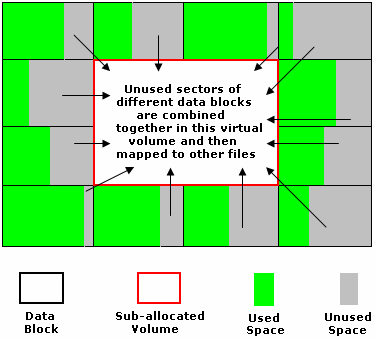Recovering Deleted/Lost/Missing Data From Novell Servers

Fig: Space optimization using Sub-allocated volumes The sub-allocated volume is virtual - it does not show up as a separate logical volume. It is internally used by the Operating System (NetWare 4.x) to optimize disk space utilization.
Sub-allocation was a useful feature in NWFS which uses 64K blocks. NSS, which uses 4K blocks, do not have much use for sub-allocation.
Segmented Volumes
Segmented volumes refer to volumes which have had their size increased by taking disk space from another area. This space is usually taken from another disk, resulting in the Volume existing in 'segments' across different disks, and hence the name segmented volumes. Segmented volumes add flexibility and are particularly useful in cases of important volumes needing additional disk space. A volume may be spanned across as many as 32 hard disks.

Fig: Volume X is a segmented volume spanned across 3 hard disks For Example: Say, a disk consists of 2 volumes, one of which is almost full up and needs additional space. NetWare uses a feature using which disk space, usually from a separate disk, can be added to an existing volume.
While Segmented Volumes do make for increased volume size, the downside is that the volume gets fragmented.
1.3 How data gets lost
Data loss can be just a click away and usually occurs when least expected. Some of the leading causes of data loss:
The biggest factor leading to data loss is hardware malfunction. Hard disks are mechanical devices and therefore fall victim to wear and tear – estimates put the average life of a hard disk at 3 years and it's easy to see why - picture a series of disk platters rotating at 10,000 times per minute (over a 150 times a second!) with disk heads moving over them, separated at submicron distances. The margin for error, for mechanical movements inside the disk, is minimal. Even slight vibrations can unsettle alignments, and dropping a disk to the floor can be thought of as a minor catastrophe – in fact, Head/Media collisions account for a large percentage of hardware malfunctions. Add to this other factors such as settling of dust particles on magnetic surfaces, sudden temperature variations, electronic (circuit board) failures, Controller failures, power surges, etc and one can understand the relatively short life span of hard disks – a hardware malfunction can occur at any time and is sometimes beyond the control of the user.
Human error (accidental deletion/format, incorrect usage of software, etc) and software malfunction (corruption by virulent software, configuration complexity, improper backups, etc) are other major factors leading to data loss. While virus attacks are an issue with other Operating Systems (most notably Windows), this is not much of an issue in NetWare.
1.4 Data safety methods provided by NetWare & its limitations
Although NWFS has limited data safety/protection methods, NSS comes with useful features some of which are: |